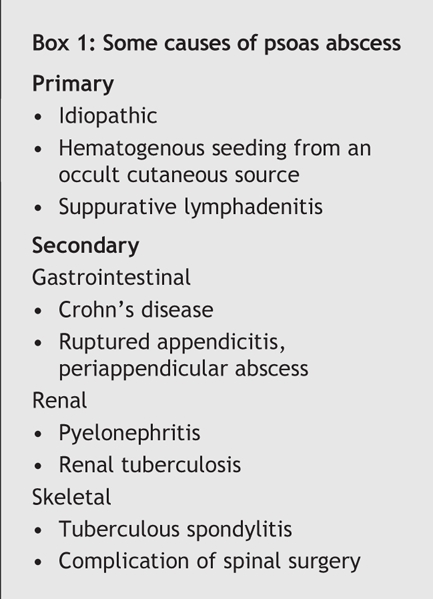A previously well 12-year-old boy presented after 1 month of increasing right-sided hip pain with a limp, decreased energy and a 2-kg weight loss. He had no history of trauma, other joint problems, recent travel or contact with ill people. He had no abdominal pain or change in his bowel habits.
The patient was prepubertal, weighed 30.5 kg (< third percentile) and was 144 cm tall (tenth percentile). He had a low-grade fever (38.2°C), a limp and pain in his right hip with a positive psoas sign, and digital clubbing. He had microcytic anemia (hemoglobin concentration 72 [normal 120– 160] g/L), a leukocyte count of 17.2 (normal 4–10) × 109/L, a platelet count of 1013 (normal 150–400) × 109/L, an erythrocyte sedimentation rate of 116 (normal 1–10) mm/h and a serum albumin level of 26 (normal 32–56) g/L.
Findings on plain-film radiography of the right hip were normal. An MRI showed a psoas abscess (Fig. 1, arrow) and thickening of the cecal, ascending colon and proximal transverse colon walls, which suggested inflammatory bowel disease. Further investigations, including a double-contrast upper gastrointestinal series with small-bowel follow through and colonoscopy, confirmed the diagnosis of Crohn's disease with a fistula causing the abscess. The patient's condition improved with percutaneous drainage of the abscess, broad-spectrum antibiotic therapy and enteral feeding. Abscess cultures grew fecal flora.

Fig 1: MRI showing psoas abscess in right hip (arrow).
Abscesses of the psoas muscle are rare. They may be classified as primary or secondary (Box 1). In developing countries, they are most commonly caused by tuberculous spondylitis.1 Psoas abscesses in children are usually primary, and the organism most frequently cultured is Staphylococcus aureus.
Box 1.

The classic presentation includes fever, back pain and a limp. However, children may present with abdominal or genitourinary complaints, given the multiple anatomic structures adjacent to the psoas muscle. A history of trauma or infection is neither consistent nor reliable. Common clinical signs include a positive psoas sign (pain when the hip is passively extended or actively flexed against resistance), which is attributed to inflammation causing spasm of the psoas muscle, and femoral neuropathy, which includes a limp or a flexion deformity of the involved hip. The differential diagnosis of hip pain and limp in children includes septic arthritis, osteomyelitis, abscess of the psoas or internal obturator muscle, transient synovitis, juvenile rheumatoid arthritis, congenital hip dislocation, Legg-Calvé-Perthes disease, slipped upper femoral epiphysis and malignant disease.
CT scanning is an accurate, rapid and noninvasive method for diagnosing psoas abscess and delineating its cause. Extraperitoneal surgical drainage has been the standard method of treatment; however, image-guided percutaneous drainage has become an effective alternative.2 Surgery is indicated when percutaneous drainage fails, a multiloculated abscess is discovered on CT or an underlying pathologic process necessitates a definitive surgical procedure.
In our patient, Crohn's disease was only suspected after finding the abscess. Intra-abdominal abscesses occur in 7%–28% of adults with Crohn's disease, and abscess of the psoas muscle occurs in 0.4%–4%.3
Celia Atkinson Shaun K. Morris Division of Pediatric Medicine Vicky Ng Division of Gastroenterology, Hepatology and Nutrition Jeremy N. Friedman Division of Pediatric Medicine Hospital for Sick Children Faculty of Medicine University of Toronto Toronto, Ont.
Footnotes
Competing interests: None declared.
REFERENCES
- 1.Kadambari D, Jagdish S. Primary pyogenic psoas abscess in children. Pediatr Surg Int 2000;16:408-10. [DOI] [PubMed]
- 2.Kang M, Gupta S, Gulati M, et al. Ilio-psoas abscess in the paediatric population: treatment by US-guided percutaneous drainage. Pediatr Radiol 1998;28:478-81. [DOI] [PubMed]
- 3.Ogihara M, Masaki T, Watanabe T, et al. Psoas abscess complicating Crohn's disease: report of a case. Surg Today 2000;30:759-63. [DOI] [PubMed]


